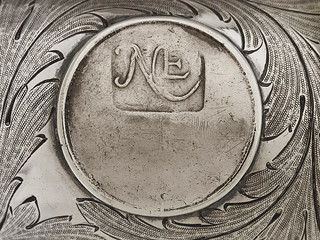
PREV ARTICLE
NEXT ARTICLE
FULL ISSUE
PREV FULL ISSUE
THE NASBY CUPA Yale University Art Gallery email highlights an amazing silver trophy adorned with coins, including a rare New England shilling described in a 2018 article by Associate Curator of Numismatics Ben Hellings. -Editor 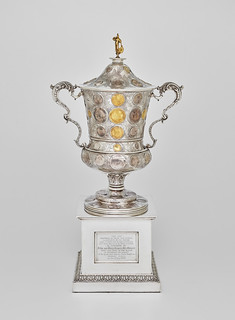
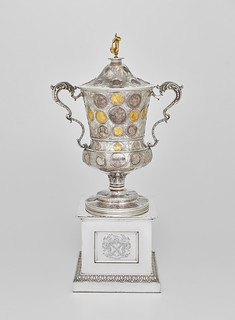
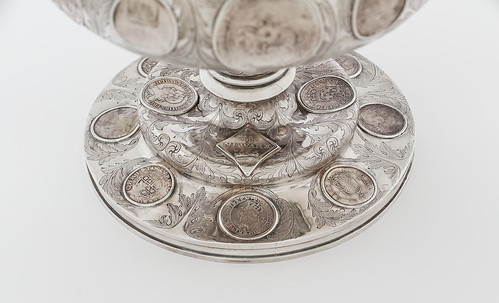
Here's an excerpt from Ben's 2018 Journal of Early American Numismatics article. -Editor The third specimen at Yale is special and only resurfaced in September 2017 while some of the collection in offsite storage was assessed. The New England shilling, together with 71 other coins, counters, and medals from the period of the English Civil Wars, is integrated into a magnificent silver trophy that commemorates the Battle of Naseby in 1645 during which Cromwell defeated King Charles I, and ultimately led to the latter's defeat in the First English Civil War. The hallmarks on the cup identify that it was produced in London in 1839 by Charles Reily and George Storer. The pedestal of the cup claims that the coins and medals are illustrative of the period and that many of them were dug at the scene of action. The commissioners of the cup, John and Mary Frances Fitzgerald, owned a larger manor nearby the battlefeld. They also erected a commemorative obelisk nearby so it is conceivable that some of the coins integrated within the silver trophy were found on the battlefeld. The heavily worn condition of some of the coins does stand at odds with the many surrounding rare and near-mint state coins, revealing that some may have been found on the field while others were deliberately collected for the cup. The New England shilling, however, cannot have been lost on the field of battle since it occurred prior to the striking of the coin, although it certainly belongs to the same era.
Although there was no prohibition against the export of large quantities of Massachusetts silver until 1654, it is known that coins thereafer did pass searchers with some ending up in Britain. This offers one possible circumstance for the NE shilling to travel to Britain. The pieces, however, are unlikely to have been extensively used in trade with Britain since the New England shillings struck at a standard of 72 grains contained less silver than the English standard of 92.9 grains. The New England shillings would therefore have been unappealing to use in Britain where they could have been valued less than their face value. It is therefore possible that these coins came to Britain as a (numismatic) collector's item. The specimen in the cup is in exceptional condition indicating that it may not have circulated extensively. If this is the case, the coin could have come to Britain shortly afer its manufacture or remained in a (savings) hoard in the U.S. It may have come as part of the elite network on both sides of the Atlantic in which wealthy colonials adopted and continued old European practices of collecting and displaying silver. If so, it could have travelled with collections during the exodus of elite loyalists to Britain in the context of the American Revolution (although saving this coin in such a context would be peculiar). At the same time of the coin's manufacture, however, numismatics was starting to become a serious field of study in Britain offering yet another possible circumstance for the coin's presence in Britain. Whenever the coin did travel, the condition of the coin does allow us to speculate that it was specifcally preserved for a collection or display purpose. The question remains why a New England shilling appears on a cup commemorating a battle of the English Civil Wars. The coin certainly belongs to the period and several other foreign coins are included. Most of the "foreign" coins were those struck in Ireland and Scotland during the Civil Wars so their connection is clearer. A Spanish-American cob from Mexico City, struck under Philip V of Spain in the early 1700s, is also featured but there are several recorded finds of earlier cobs in Britain. The New England shilling may therefore have been included since it alludes to a period of unrest and turbulence that spread beyond the borders of Great Britain and Ireland. It also was the first coinage from the Puritans of the Massachusetts Bay, whose inhabitants supported their puritan brethren in Britain against King Charles I in the Civil Wars. Since Cromwell was a puritan and headed a puritan commonwealth in Britain, it therefore may have seemed appropriate to include a coin from the Massachusetts Puritans commemorating their assistance. 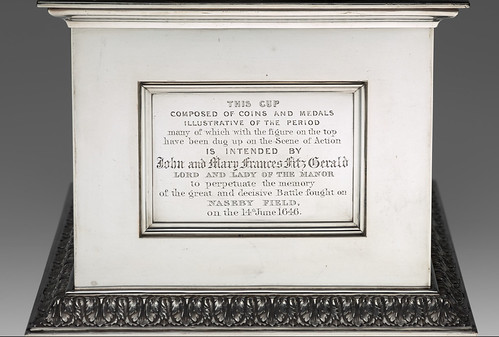
To read the complete newsletter, see:
To hear the story of the Nasby Cup, see:
To read Ben's 2018 Journal of Early American Numismatics article, see:
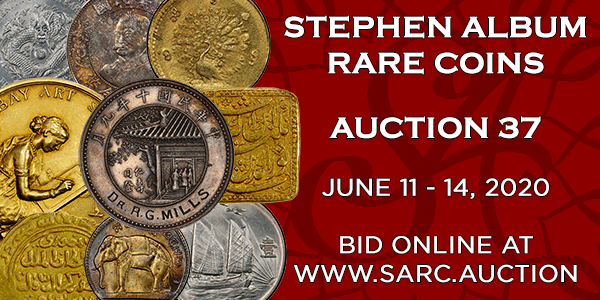
Wayne Homren, Editor The Numismatic Bibliomania Society is a non-profit organization promoting numismatic literature. See our web site at coinbooks.org. To submit items for publication in The E-Sylum, write to the Editor at this address: whomren@gmail.com To subscribe go to: https://my.binhost.com/lists/listinfo/esylum All Rights Reserved. NBS Home Page Contact the NBS webmaster 
|
